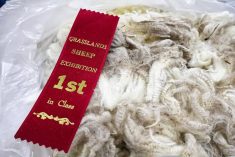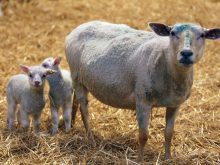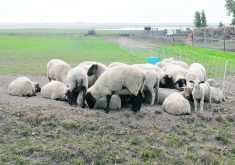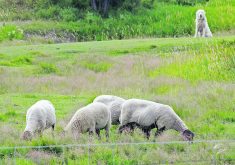A younger generation is joining the small group of professional shearers who ply their trade across Western Canada
Wrestling a bleating mass of dirty wool weighing more than 200 pounds, flipping it onto its back or side, then wielding an electric shearer — that’s the normal routine for a sheep shearer.
“It’s super physical,” said Bethan Lewis, a young shearer from Alexander, Man.
All sheep should be shorn once a year to keep them cool in summer and reduce the risk of parasites and disease. Even breeds that produce wool not typically used in yarn production must be shorn.
Lewis is one of a small group of professional shearers who ply their trade in Western Canada.
Read Also

House ag committee to undertake several studies
The House of Commons standing agriculture committee has set its agenda for the coming months. Members began the fall sitting with a two-hour update on international trade
Most sheep owners opt to have their animals shorn in spring after lambing. April, May, June and July are typically the busiest as shearers criss-cross the provinces to visit clients.
Kim MacDougall has reduced his flock of British Suffolk and North Country Cheviot sheep to about 60 ewes from 100 on his farm north of Regina, but still needs to have them shorn. He said ideally they are shorn in mid-April, but he knows this depends on his shearer’s schedule.
“The weather can ruin your plans,” he said.
Lewis calculated that she’s put about 24,000 kilometres on her new truck’s odometer since buying it in February. In her early 20s, she’s one of the younger generation of Canadian shearers. She began learning the art of shearing at age 16 from her father, John, who immigrated to Canada from the United Kingdom and went into sheep production.
“It’s been a lot of watching, learning and listening,” she said. “I’ve mostly picked up my dad’s clients or their kids.”
She has a client base of 60 sheep producers across Manitoba and expects to shear about 6,000 sheep. She prefers shearing in warmer weather because sheep’s natural lanolin then lubricates their wool, which makes shearing easier.
Primarily self-taught, shearer John Beasley, who lives near Youngstown, Alta., said he books clients from January to August, usually working between 20 and 30 days each month.
“I travel within about a six-hour radius of home,” he said.
Beasley started shearing 15 years ago, prompted by “necessity and poverty”, he joked. He had expanded his flock and was having trouble finding a reliable shearer. As an experienced farrier, he was experienced in handling animals. With the help of local shearers and through working a few seasons shearing in Ireland, Montana and Wyoming, he developed his skills.
He’s able to shear a sheep in less than two minutes but that average time is extended if the sheep has parasites. This is a problem that he encounters more frequently, and he encourages producers to maintain good stewardship of their animals.
Lewis agreed that educating some producers about animal husbandry is an important part of her job. That and the need to maintain a client schedule are sometimes tricky.
“Shearing is the easy part.”
Beasley said he prides himself on his reliability, consistency and professionalism.
“You have to consistently maintain composure.”
Now middle-aged, Beasley joked he’s slowing down with age.
But age hasn’t stopped Saskatchewan shearer Lorrie Reed and he’s in his late 60s. Reed said he schedules his clients from February to early May and then grows crops on his farm near Elrose.
Reed began shearing in 1988.
“I bought my own sheep and I thought, ‘I can do this.’”
He said he discovered there’s a lot to learn to become a professional shearer and he now mentors younger shearers, including Lewis.
“Over the last 10 to 15 years, I’ve had people come with me,” he said. “It’s kind of fun to have a younger person along.
“I travel at least 300 to 400 km a day. I charge so much a head plus mileage.”
He usually shears between 15 and 20 sheep per hour.
He said not too much has changed in Saskatchewan sheep production over the years except for the hydraulic wool press that tightly pushes between 350 and 400 pounds of wool into a huge bag. Before this invention was commonly used, someone had to stand inside the bag and stomp down on the wool to pack it.
Reed and Lewis agreed that Rambouillet sheep are the toughest breed to shear.
“They have the most wool from their heads to their toes,” Reed said.
“They’re big sheep with lots of wrinkles,” Lewis added.
Beasley said he doesn’t expect many younger people will want to learn to shear.
“I would never recommend to someone to start shearing. It’s a good living but it’s tough.”
A Manitoba Sheep Association director, Lewis was encouraged by the good response to a shearing school held earlier this spring in Brandon.
She enjoys the camaraderie she’s found at shearing events held across Western Canada.
While she also works as a provincial crop adjuster, Lewis said shearing is an important part of her life.
“I always say to people, ‘it’s an addiction.’”

















